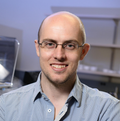
Structural and Biophysical Studies of Tafazzin
Steven Glynn, Associate Professor, Stony Brook University, Stony Brook, NY
Award - $50,000 over 2-year period
This project’s funding was made possible by a generous contribution from our affiliate Association Syndrome de Barth France.
Tafazzin catalyzes the transfer of unsaturated acyl chains to generate mature cardiolipin at the mitochondrial inner membrane. Mature cardiolipin is essential for the proper organization and function of the inner membrane and reduction in cardiolipin level impairs cristae formation and energy production. At least 50 missense mutations in Tafazzin have been identified in patients with Barth syndrome (BTHS), an X-linked disease characterized by multiple myopathies and cyclic neutropenia. These mutations impair Tafazzin activity, resulting in reduced cardiolipin levels and accumulation of phospholipid precursors. Thus, the activity of Tafazzin appears to be inextricably linked to the development of Barth syndrome in patients. In this proposal, we seek to determine the atomic resolution structure of yeast Tafazzin to provide the first structural insights into this enzyme from any species.
36 of the 50 BTHS patient mutations in human Tafazzin are located at identical or highly similar positions in the yeast enzyme making it an excellent model to study the molecular basis of this disease. This structure will reveal the mechanisms of specificity and catalysis of cardiolipin maturation at the inner membrane and provide a structural framework for rationalizing impaired Tafazzin activity caused by BTHS patient mutations. Furthermore, we will use biophysical methods to probe defects in Tafazzin stability caused by one class of BTHS mutations that have been shown to induce its degradation by an intermembrane space protease. Together, these studies will shed light on the molecular mechanisms of BTHS mutations within Tafazzin and demonstrate a key hypothesis to understand how one class of mutation can lead to disease.



